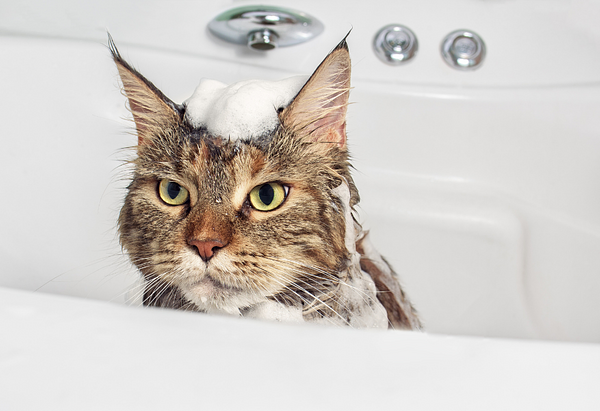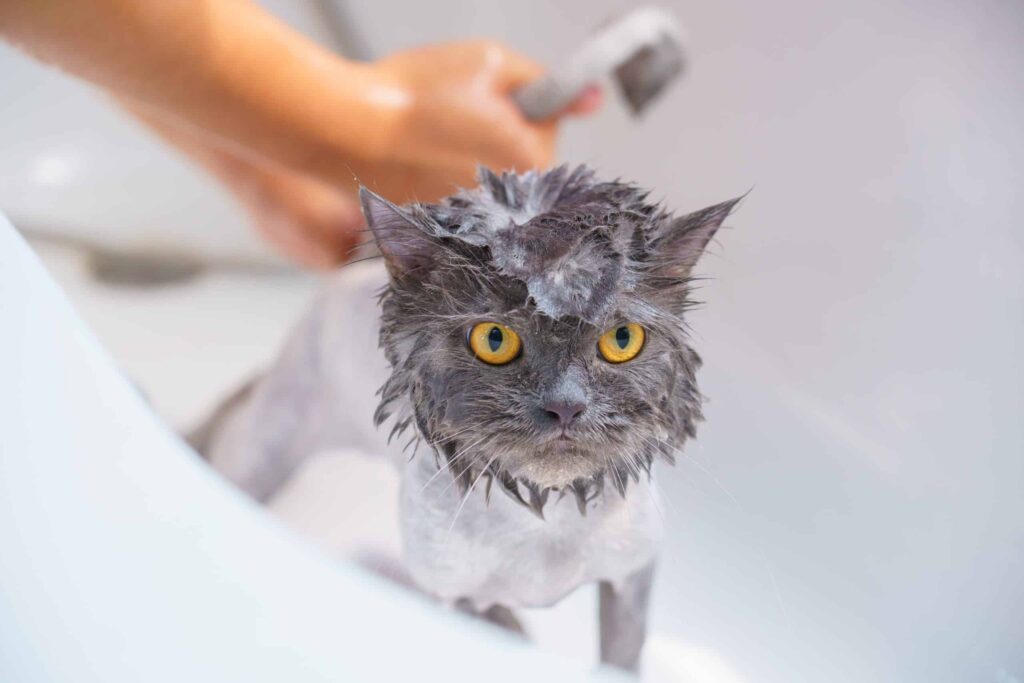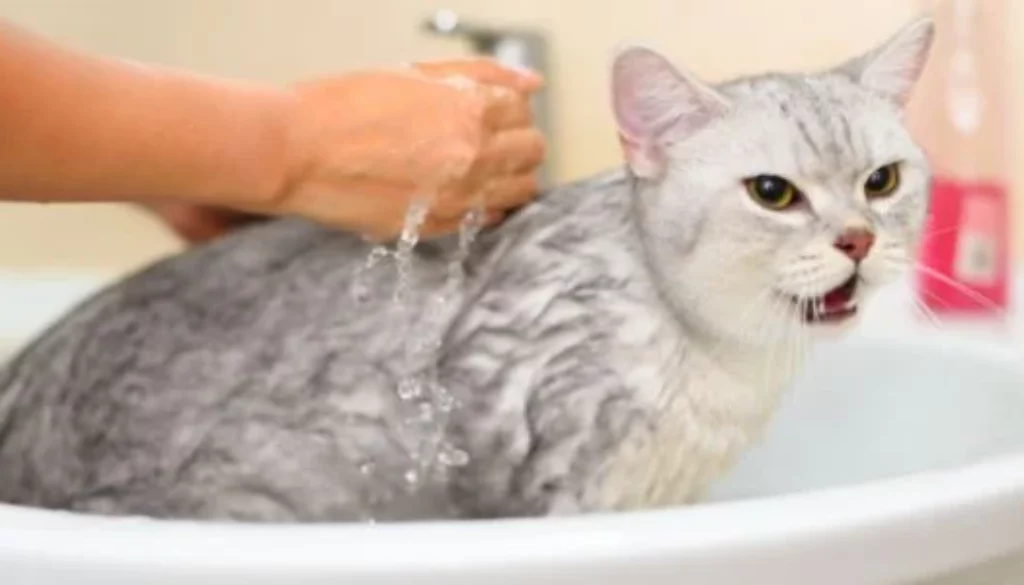Training a Cat to Enjoy Bath Time: Is It Possible?
Bathing a cat can be a challenging task for many pet owners, as most felines have a natural aversion to water. However, with patience, positive reinforcement, and proper training techniques, it is possible to help your cat overcome their fear and even enjoy bath time. In this article, we will explore the secrets to successfully training a cat to enjoy bath time. Learn effective strategies and techniques to make this experience pleasant for both your cat and yourself.
Cats are notorious for their dislike of water, often displaying an array of vocal protests, scratches, and attempts to escape during bath time. This aversion is rooted in their instinctive behavior as self-grooming animals who prefer to maintain their own cleanliness. However, there are certain situations where bathing becomes necessary, such as dealing with skin conditions, fleas, or simply keeping your cat’s coat in top condition. By approaching bath time training in a gradual and positive way, you can help your cat overcome their fear and establish a more enjoyable bathing routine.
Understanding a Cat’s Aversion to Water
It is essential to understand the underlying reasons behind a cat’s aversion to water before attempting to train them for bath time. Cats are naturally equipped with unique features that help them self-groom efficiently, such as their rough tongues and saliva. Their fur is coated with natural oils that act as a protective barrier and help regulate their body temperature. Introducing water disrupts this delicate balance, resulting in their instinctual resistance and fear.
The Importance of Regular Bathing for Cats
While cats are generally excellent self-groomers, there are instances where they may require assistance in maintaining their hygiene. Regular bathing helps remove dirt, dander, and allergens from their coats, reducing the risk of skin infections and allergies. It is also crucial for managing conditions like dermatitis and fleas. By incorporating regular bathing into your cat’s routine, you can ensure their overall well-being and prevent potential health issues.
Preparing the Bathing Area
Before initiating the actual bathing process, it is essential to create a calm and safe environment that will help your cat feel more relaxed. Start by selecting a warm room with a non-slip surface, such as a bathroom or utility area. Gather all the necessary bathing supplies, including a cat-friendly shampoo, towels, and a handheld sprayer, if needed. It is crucial to set the atmosphere by playing soothing music and ensuring minimal distractions.

Slowly Introduce Your Cat to Water
The key to successful cat bath training lies in gradual exposure to water. Begin by introducing your cat to the bathing area without any water present. Allow them to explore the space, sniff the bathing supplies, and become familiar with their surroundings. Reward positive behaviors, such as calmness and inquisitiveness, with treats or verbal praise, and avoid any negative reactions or punishments.
Using Positive Reinforcement Techniques
Positive reinforcement is a powerful tool when training a cat to enjoy bath time. Use treats or their favorite toys as rewards for small steps towards the bathing process, such as approaching the tub or allowing gentle touches with wet hands. By associating these positive experiences with bath time, you can gradually build your cat’s confidence and willingness to participate.
Gradually Increasing Water Exposure
Once your cat is comfortable in the bathing area, you can begin introducing small amounts of water. Start by using a shallow container or sink filled with lukewarm water, allowing your cat to dip their paws willingly. Monitor their reactions closely, rewarding any signs of calmness or curiosity. Increase the water level gradually over multiple sessions, always keeping a calm and reassuring tone.
Choosing the Right Cat-Friendly Products
Selecting the appropriate products for bathing your cat is essential to ensure their comfort and safety. Opt for cat-specific shampoos that are formulated to be gentle on their sensitive skin and free from harsh chemicals. It is advisable to consult with your veterinarian to find the most suitable product for your cat’s specific needs. Additionally, using a handheld sprayer or a wet cloth for rinsing can help maintain control and minimize stress during the bath.
Grooming Techniques During Bath Time
Incorporating gentle grooming techniques during bath time can help your cat associate the experience with a positive touch and relaxation. Use a soft brush or comb to gentle detangle their fur, removing any loose hair or mats. This can reduce post-bath grooming anxiety and make the overall process more enjoyable for your cat.
Dealing With a Resistant Cat
Some cats may exhibit more resistance towards bath time despite your best efforts. If your cat becomes anxious, aggressive, or excessively stressed during the training process, it is crucial to prioritize their well-being. Forcing a resistant cat into a stressful situation can be counterproductive and risk causing long-term aversion to water. In such cases, consider seeking professional help from a veterinarian or a professional cat behaviorist who can provide additional guidance and behavioral modification techniques.
Seeking Professional Help if Needed
If you encounter significant difficulties in training your cat to enjoy bath time, do not hesitate to seek professional assistance. Veterinarians, groomers, and animal behaviorists have experience and expertise in handling cat behavior and can provide tailored advice and strategies for your specific situation. They can also identify any underlying reasons contributing to your cat’s aversion to water and offer appropriate solutions.
Additional Tips for Successful Bath Time
Here are some additional tips to enhance the success of your cat’s bath time training:
- Establish a consistent routine: Cats thrive on predictability, so create a regular bath time schedule to help them feel more comfortable.
- Use calming aids: Natural remedies, such as pheromone diffusers or calming sprays, can help reduce anxiety and promote relaxation before and during bath time.
- Practice patience and persistence: Rome wasn’t built in a day, and neither is a cat’s tolerance for water. Remember to be patient, and persistent, and celebrate even small victories during the training process.
- Gradual exposure to different stimuli: Once your cat becomes more comfortable with water, gently introduce other elements associated with bathing, such as the sound of running water or the sensation of being towel-dried.
- Maintain a positive attitude: Cats are incredibly perceptive to human emotions. Maintaining a calm and positive attitude during bath time will significantly influence your cat’s behavior and overall experience.

Common Mistakes to Avoid
While training your cat to enjoy bath time, it is essential to be aware of common mistakes that can hinder progress:
- Forcing or rushing the process: Pushing your cat beyond their comfort zone can lead to increased fear and resistance. Take the time to build trust and progress at a pace that suits your cat’s individual needs.
- Using harsh techniques or punishment: Resorting to harsh handling or punishment during bath time can create a negative association. Focus on positive reinforcement and rewards instead.
- Neglecting safety precautions: Always ensure the bath area is secure and free from potential hazards. Avoid using excessive water pressure, keep their face dry, and be cautious of any signs of stress or distress.
- Skipping regular grooming: Bath time should not replace daily grooming. Regular brushing and grooming help maintain a healthy coat and reduce the risk of matting or skin problems.
- Neglecting aftercare: After bath time, ensure your cat is thoroughly dried and provided with a warm, comfortable space to relax. This will help them recover from any stress associated with the bathing process.
FAQs: Training a Cat to Enjoy Bath Time
- Can I use human shampoo to bathe my cat?
It is not recommended to use human shampoo on cats. The pH balance and ingredients in human shampoos differ from those specifically formulated for felines, which can cause skin irritation and other adverse reactions. - How often should I bathe my cat?
The frequency of bathing depends on several factors, such as your cat’s breed, coat type, and overall hygiene. Most cats only require bathing every few months unless they have specific health or skin conditions that require more frequent baths. - What if my cat still hates bath time after training?
Some cats may never fully enjoy bath time, and that is okay. As long as you can safely and effectively bathe your cat without causing excessive stress or harm, occasional baths may be sufficient. - Are there alternative grooming options for cats who dislike water?
Yes, there are alternative grooming options available, such as dry shampoos or grooming wipes designed for cats. These products can help keep your cat clean and fresh between baths. - How long does it take to train a cat to enjoy bath time?
The training timeline varies for each cat, depending on their personality, past experiences, and level of fear towards water. It can take weeks or even months to fully train a cat to enjoy bath time, so patience and persistence are key.
Conclusion
Training a cat to enjoy bath time is a gradual process that requires patience, positive reinforcement, and a deep understanding of feline behavior. By respecting your cat’s boundaries, creating a calm environment, and gradually introducing water, you can help your cat overcome their aversion and develop a more positive association with bath time. Remember to prioritize your cat’s well-being and seek professional assistance if needed. With time and proper training, bath time can become a stress-free experience that benefits both you and your beloved feline companion.
Also Read:
Pet Care Tips for Cats for Beginners
Pet Care Tips for Dogs for Beginners



